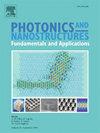Tunable ultra-sensitive four-band terahertz sensors based on Dirac semimetals
IF 2.5
3区 物理与天体物理
Q3 MATERIALS SCIENCE, MULTIDISCIPLINARY
Photonics and Nanostructures-Fundamentals and Applications
Pub Date : 2025-02-01
DOI:10.1016/j.photonics.2024.101347
引用次数: 0
Abstract
This article presents a classic three-layer structure terahertz four-band absorber that is composed of Dirac semimetals (BDS) and silica. By regulating the Fermi energy of the Dirac semimetals, it becomes possible to adjust the frequency of the absorption peaks of the absorber. Specifically, when a Fermi energy of 50 meV was chosen for the Dirac semimetal, four absorption peaks were generated within the 4–8 THz range, and all of these peaks boasted absorption rates exceeding 95 %. Firstly, the structural characteristics of the absorber were introduced, and its feasibility was demonstrated by relying on the impedance matching theory. Subsequently, the variations in the electric field on the surface of the absorber were investigated through the application of the Local Surface Plasmon Resonance (LSPR) theory. Moreover, by modifying the structural parameters, it was found that the absorber possesses excellent physical tuning capabilities. After exploring how changes in the environmental refractive index influence the device's functionality, it was also discovered that the absorber shows remarkable sensitivity to the refractive index, reaching 1840 GHz/RIU. This makes it a highly promising candidate for sensing applications. In conclusion, the design of this absorber offers a novel approach for tunable terahertz metamaterial absorbers, which holds great significance in various fields like detection and sensing.
基于狄拉克半金属的可调谐超灵敏四波段太赫兹传感器
本文介绍了一种由Dirac半金属(BDS)和二氧化硅组成的经典三层结构太赫兹四波段吸收体。通过调节狄拉克半金属的费米能量,可以调节吸收器吸收峰的频率。具体来说,当为Dirac半金属选择50 meV的费米能量时,在4-8 太赫兹范围内产生了四个吸收峰,并且所有这些峰的吸收率都超过95 %。首先介绍了吸波器的结构特点,并利用阻抗匹配理论论证了其可行性。随后,应用局部表面等离子体共振(LSPR)理论研究了吸收体表面电场的变化。此外,通过对结构参数的修改,发现该吸波器具有良好的物理调谐能力。在探索了环境折射率的变化如何影响器件的功能后,还发现吸收器对折射率的灵敏度非常高,达到1840 GHz/RIU。这使它成为传感应用的一个非常有前途的候选者。综上所述,该吸波器的设计为可调谐太赫兹超材料吸波器提供了一条新途径,在探测、传感等领域具有重要意义。
本文章由计算机程序翻译,如有差异,请以英文原文为准。
求助全文
约1分钟内获得全文
求助全文
来源期刊
CiteScore
5.00
自引率
3.70%
发文量
77
审稿时长
62 days
期刊介绍:
This journal establishes a dedicated channel for physicists, material scientists, chemists, engineers and computer scientists who are interested in photonics and nanostructures, and especially in research related to photonic crystals, photonic band gaps and metamaterials. The Journal sheds light on the latest developments in this growing field of science that will see the emergence of faster telecommunications and ultimately computers that use light instead of electrons to connect components.

 求助内容:
求助内容: 应助结果提醒方式:
应助结果提醒方式:


